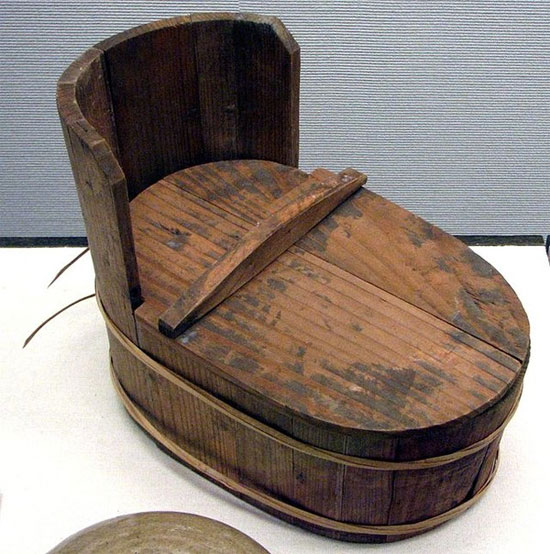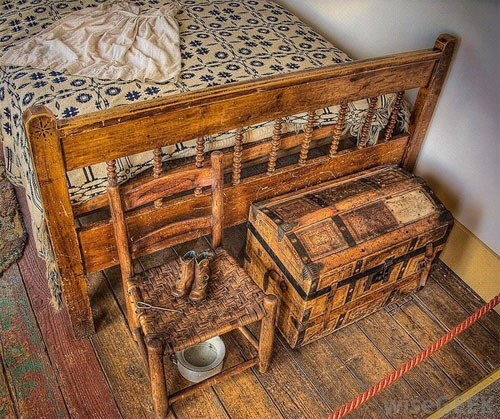The 'unsanitary' habits of the Middle Ages made you cry
Keeping body waste under the bed, using urine to wash your face, not changing dirty clothes . are the 'unsanitary' habits that were present during the Middle Ages.
Have you ever imagined how you would live without changing clothes for a month? Or what if you wash your face every day with . urine?
Certainly those things will make you goosebumps because of fear. However, in the Middle Ages (V century - XV century), this was a habit of not only one person but hundreds of thousands of others on the planet.
So what about the 'unsanitary' habits that appeared in the world at that time? Let's find out the following list to get the answer.
1. Go to the bathroom and keep the 'product' immediately under the bed

An old wooden potty
Going out at night to 'resolve sadness' was a scary thing for those who lived in the Middle Ages. To solve this problem, ancient Europeans used potty and waste containers in their homes.

When there is a need, they just need to go to the bathroom right inside the house without going out. The product will be stored in the potty under the bed and kept for a few days afterwards.
2. Extraction of teeth in a hair salon

During the Middle Ages, dentists were a concept that did not exist in society. At that time, people with gum disease often had only one treatment, which was signaling . cutting hair.

Here, barbers will use pliers to help them extract their teeth without caring about what disease they have. Of course, the implements are rarely cleaned as clean as they are today, so it is not difficult to understand when oral diseases will get worse after curing.
3. Use leaves to make toilet paper
In the Middle Ages, noble kings often hired private servants to take care of their hygiene after 'addressing the need'.

These types of leaves are so big that they are utilized by the Middle Ages
As for civilians, they were forced to take care of themselves using toilet paper. But because of their tight economy, they often use big leaf leaves to make toilet paper for themselves.
4. Ancient people rarely change clothes

For poor people, it is difficult to have clothes to wear as many clothes to change constantly
In Medieval Europe, the number of clothing apparel is not much and popular. An average person only has 4 suits for each season lasting 3 months. Therefore, they often have to wear dirty clothes for weeks.

Portrait of King James VI of Scotland - a "dirty" noble whose language is medieval
Even the royal members also have the habit of. King James VI of Scotland even wore dirty clothes to sleep and did not change for months.
5. Use old rags and moss as sanitary pads

Poverty and underdevelopment of science make the "red lights" become the nightmare of ancient women
In ancient Egypt, women used papyrus to be kept clean during the 'red light' days. Meanwhile, the Greek women's toilet used a rag wrapped around a small piece of wood.

Dry moss with wiping cloths can also become sanitary pads for medieval women
But in many other parts of the world, many women even use moss and animal skin as sanitary napkins for poverty.
6. Wash your face with urine

Ancient European nobility believe that urine antiseptic is good for the skin. So women in the royal family loved to use urine for their facials.

In addition, they also mixed urine with lye to wash clothes. By the Victorian period (around the nineteenth century), urine and alcohol were even considered medical antiseptics.
7. Use animal fat to make hair more beautiful

Thick, curly and fluffy hair is always the dream of women in the Middle Ages, especially in the noble and noble families.

Therefore, in the banquet party, many women use animal fat to have beautiful hair like that. These hairstyles look very beautiful but smell unpleasant and very easily catch fire.

To hide the unpleasant odor of hair, women at that time often used the essence of a rich perfume.
8. Burn the wound to prevent infection

For medieval knights, infected wounds always cause discomfort. Therefore, they often seek out blacksmiths for treatment.
Here, blacksmiths will use red hot iron bars to burn the patient's open wounds. They conceived that while suffering the pain, the temperature of the iron rod will also kill the bacteria and bacteria of the wound.
9. Use sulfur to cure acne and freckles

Freckles - the terror of medieval women
In the past, freckles and acne were always considered to be the horror of women. Therefore, ancient European women thought of a beauty method: using sulfur powder to rub their face.

Sulfur powder - the extremely dangerous freckle cosmetics that old women didn't know
They believe that rubbing sulfur on your face daily will help minimize the appearance of freckles quickly. This habit only disappears when scientists discover that sulfur powder is dangerous to humans and not as mistaken.
- The truth of mythical myths about the Middle Ages
- 5 silly predictions about the Middle Ages Day
- The misconception of the Middle Ages makes you laugh!
- The rich in the Middle Ages suffered from lead poisoning due to their preference for ceramics
- Eyes round with 6 ridiculous bans on ridiculous Middle Ages
- This is the reason why we often do blankets when sleeping no matter how hot it is
- The three most notorious tyrants of the Middle Ages night
- You: Discover new treasure from the Anglo-Saxon era
- 16 grisly torture methods of the Middle Ages
- Detecting longevity oak from the Middle Ages
- Scary healing ways in the Middle Ages
- Medieval book art: Great creativity!
 'Fine laughs' - Scary and painful torture in ancient times
'Fine laughs' - Scary and painful torture in ancient times The sequence of numbers 142857 of the Egyptian pyramids is known as the strangest number in the world - Why?
The sequence of numbers 142857 of the Egyptian pyramids is known as the strangest number in the world - Why? History of the iron
History of the iron What is alum?
What is alum?